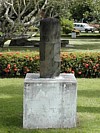|
linga (लिङ्ग)
Sanskrit. ‘Emblem, gender, symbol’. A representation of a phallus, the symbol of the creative power of
Shiva. When a face is added to its surface it is called
mukhalinga,
a ‘linga with a face’, and the representation of a linga with a single face is called
ekamukhalinga (fig.). There are many different types, often divided into three parts
corresponding to the
Trimurti (fig.),
i.e. a cubic base representing
Brahma (fig.), an octagonal prism representing
Vishnu
(fig.), and a cylindrical part with a rounded top representing
Shiva
(fig.).
The cult is worshipped in India and Southeast Asia, by some even to this day (fig.).
It is believed that water —or sometimes milk— passed over a linga becomes
sacred, even magical. People of the past even carved lingas into the riverbed,
such as in Kbal
Spean
in the jungle near
Angkor
in
Cambodia,
and at Sahasralinga near Sirsi Taluk in Uttara Kannada of Karnataka state in
India,
or alternatively placed removable stone slabs with
carved lingas (fig.) in the rivers, in
order to fertilize the water that fed their
rice paddies.
This ancient practice is today also represented in a water basin at the
Hindu
temple
Wihaan Sadet Pho Phra Siwa
(fig.)
in
Bangkok.
When Mahayana
Buddhism, introduced to Cambodia as state religion by the Khmer King
Jayavarman
VII
(fig.), was after his death once again replaced by
Hinduism, many of the
Buddha images were crudely altered into Hindu lingas. Also Shivalinga, lingum or lingam, and in Thai
ling,
leung,
siwaleung and
siwaling.
In combination (fig.)
with the
yoni
it represents creation.
An assorted collection of different styles of linga and yoni are on permanent
display at the Angkor National Museum in Siem Reap (fig.) See also
pladkik and compare with
lak meuang.
回






|

